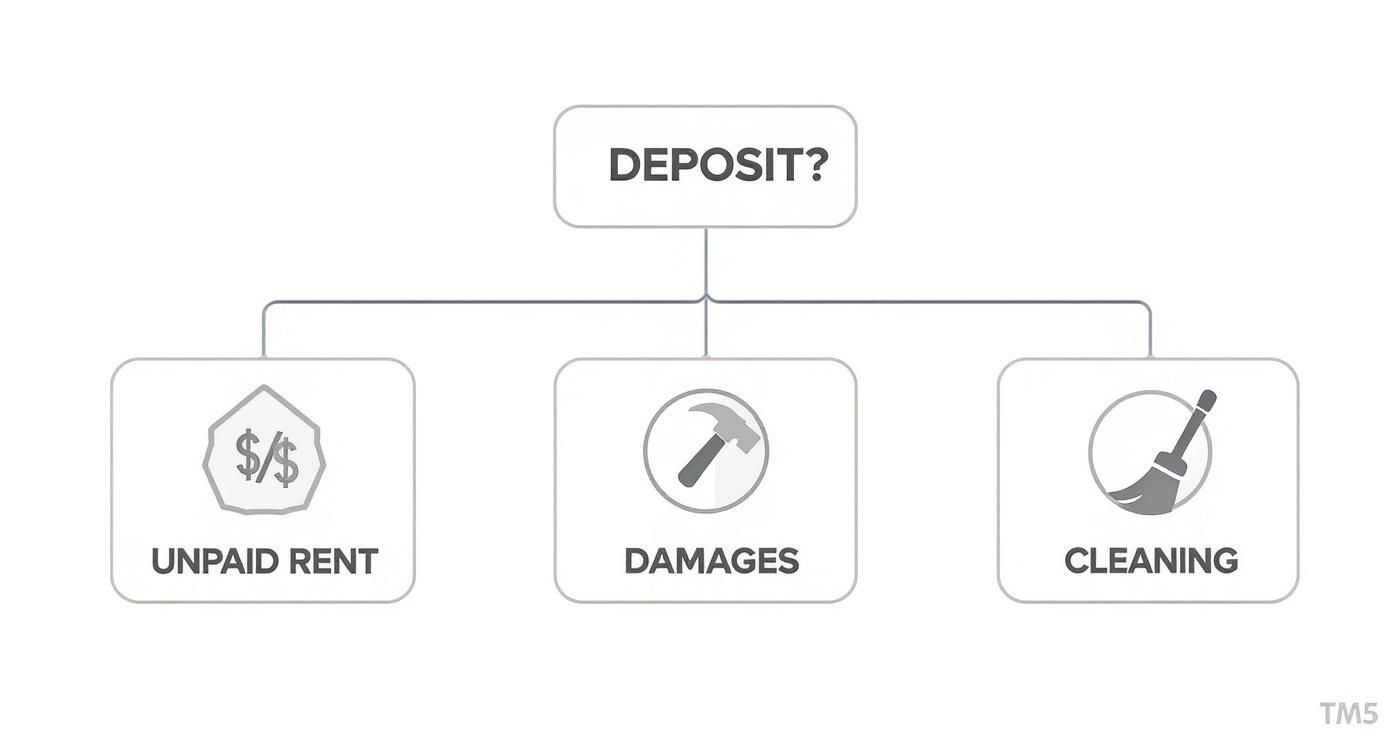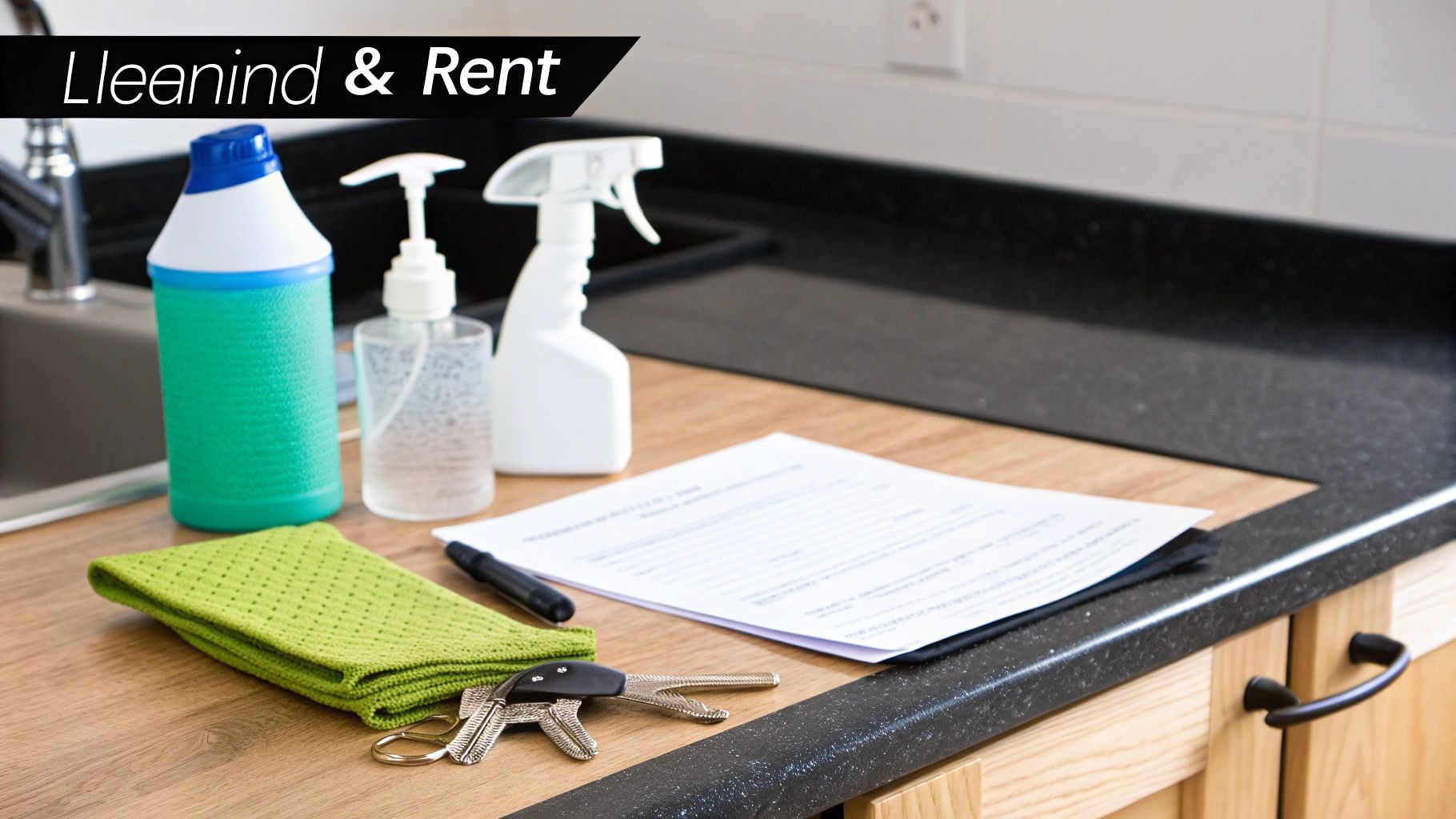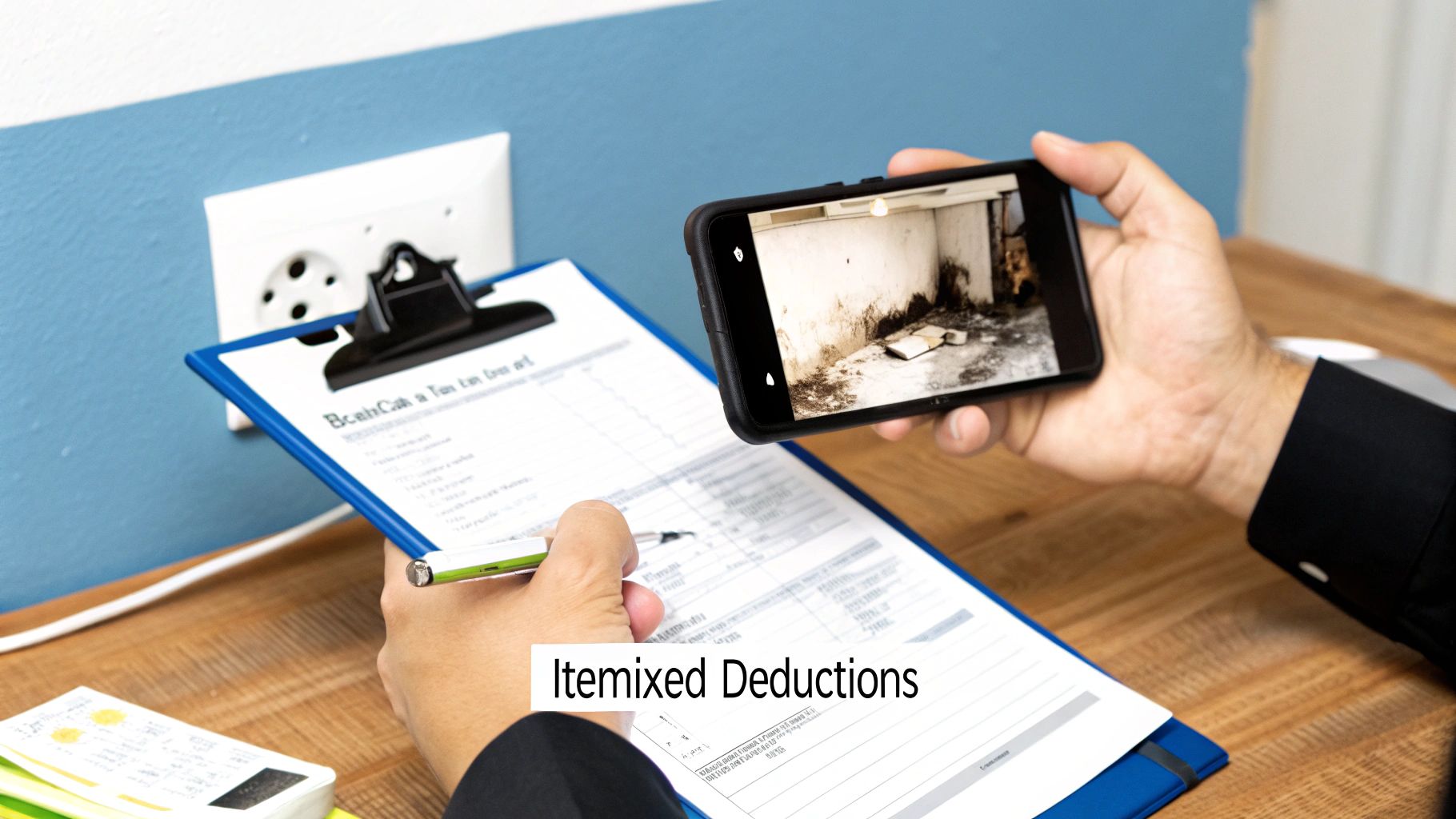What can landlords deduct from security deposit: Quick guide
- Sarah Porter
- 13 hours ago
- 10 min read
When a lease ends, one of the biggest questions for both landlords and tenants is what happens to the security deposit. Can a landlord keep it all? Just a portion? What for?
Think of a security deposit as a financial safety net for the property owner, but one that comes with a very specific set of rules. Generally, landlords can legally make deductions for three key reasons: unpaid rent, property damage that goes beyond normal wear and tear, and significant cleaning costs needed to return the unit to its original state.
Why Security Deposits Exist in the First Place
A security deposit isn't a bonus payment for the landlord or a random fee. Its sole purpose is to cover actual, documented financial losses the landlord experiences because of a tenant's actions or inaction. Grasping this core principle is the first step to handling deductions correctly and legally.
Across the U.S., the fundamental reasons for deductions—rent, damages, and cleaning—are pretty universal. What does change from place to place are the limits. Most states cap the maximum deposit a landlord can charge, often at one or two months' rent. It's always a good idea to explore security deposit statistics to get a feel for the norms in your specific market.
The laws governing these deposits are designed to create a fair system for everyone involved:
For Landlords: It’s a practical way to recover legitimate costs for repairs or missed rent without having to immediately resort to small claims court.
For Tenants: It protects them from a landlord making up arbitrary charges or using their deposit to pay for routine maintenance and upgrades.
A security deposit really works as a form of mutual assurance. It gives the landlord peace of mind that their property will be cared for, while the tenant knows their money is refundable as long as they hold up their end of the lease.
At the end of the day, the goal is simple: the tenant should leave the rental in the same condition they found it, accounting for the gentle, unavoidable effects of everyday living.
Here is a quick overview of what landlords can typically deduct from a security deposit.
Allowable Security Deposit Deductions at a Glance
This table breaks down the most common and legally permissible deductions landlords can make. Remember to always check your local and state laws, as specific rules can vary.
Deduction Category | What It Covers | Example |
|---|---|---|
Unpaid Rent | Any rent, late fees, or other charges contractually due under the lease that the tenant has not paid. | The tenant moves out but still owes $500 for the final month's rent. |
Property Damage | Repairs for damage that is not considered "normal wear and tear." This includes intentional or negligent harm. | A large, deep scratch in a hardwood floor or a baseball-sized hole in the drywall. |
Cleaning Costs | The cost to restore the rental unit to the level of cleanliness it had at the start of the tenancy. | Professional carpet cleaning to remove significant pet stains and odors. |
Unpaid Utilities | Utility bills that were the tenant's responsibility per the lease but were left unpaid at move-out. | A final water bill of $75 that was left in the landlord's name and is now past due. |
Understanding these categories is crucial for a smooth and legal move-out process. Keeping detailed records, including a move-in checklist and photos, is the best way to justify any deductions and avoid disputes.
Damage vs Normal Wear and Tear Explained
This is where things can get tricky. The line between normal wear and tear and actual damage is the single most common source of security deposit disputes. Getting this right isn't just a good idea—it's absolutely critical for legally handling a tenant's deposit.
Think of it like owning a car. The tires gradually lose tread from normal driving, which is expected. But a slash in the sidewall? That's damage. The same principle applies to your rental property.
Normal wear and tear is the natural, gradual decline a property experiences from a tenant simply living there. It’s the unavoidable result of day-to-day use. This includes things like paint that has faded slightly from sunlight, a few minor scuffs on the wall where a couch was, or carpet that's a bit worn in the main walkway. You can't deduct for these things; they're considered a normal cost of doing business as a landlord.
Damage, on the other hand, is caused by a tenant's negligence, carelessness, or outright abuse of the property. It goes far beyond the gentle effects of time. We’re talking about a large hole punched in the drywall, a cracked window from a baseball, or pet urine stains that have soaked through the carpet and into the subfloor. These are not expected outcomes, and you can absolutely deduct the repair costs.
This visual decision tree breaks down the three main reasons you might need to make a deduction.

As the infographic shows, deductions generally fall into three buckets: unpaid rent, property damage, or significant cleaning needs. Each one needs clear justification.
Comparing Wear and Tear vs Damage
Let's put some real-world examples side-by-side to make this distinction completely clear.
Property Area | Normal Wear and Tear (Not Deductible) | Damage (Deductible) |
|---|---|---|
Walls | Faded paint, minor scuffs, a few small nail holes | Large holes, unapproved paint colors, crayon marks |
Floors | Worn finish in walkways, light carpet thinning | Deep scratches, burns, large stains, broken tiles |
Fixtures | Loose grout around tiles, wobbly toilet seat | Cracked countertop, broken toilet tank, ripped blinds |
The key question to ask yourself is this: "Did this happen because someone was just living here normally, or was it the result of an accident, neglect, or abuse?" Your answer is what separates a business expense from a deductible one.
The absolute best way to protect yourself and justify any deductions is through meticulous documentation. To master this, check out our complete [landlord's guide to rental property inspections](https://www.mypropertymanaged.com/post/a-landlord-s-guide-to-rental-property-inspections). Having detailed records from move-in and move-out inspections—with plenty of photos—gives you undeniable proof if a dispute ever arises.
Navigating Deductions for Cleaning and Unpaid Rent

Aside from physical damages, the two most common reasons to dip into a security deposit are for cleaning costs and unpaid rent. On the surface, these seem simple, but knowing exactly where the legal lines are drawn is crucial for staying out of trouble.
When it comes to cleaning, the golden rule is that the tenant needs to leave the property as clean as they found it. You can't use their deposit to pay for your standard turnover clean between tenants or to upgrade the unit. You absolutely can, however, deduct for cleaning that goes well beyond a simple wipe-down.
Allowable Cleaning Deductions
Legitimate cleaning deductions are all about bringing the unit back to its original move-in condition—nothing more. Think of it as hitting the reset button, not funding an improvement project.
Here are a few clear-cut examples of when a deduction is justified:
Serious Grime: Think caked-on grease on the stove, thick soap scum in the shower, or layers of filth on the floor that require deep cleaning.
Abandoned Belongings: You can charge for the cost of hauling away any trash, junk, or furniture the tenant decided to leave behind.
Lingering Odors: If the unit reeks of smoke or pets to the point that professional deodorizing is needed, that’s a fair deduction.
To help tenants understand what's expected, providing them with something like a comprehensive end of tenancy cleaning checklist can prevent a lot of headaches at move-out.
Deducting for Unpaid Rent and Other Dues
Unpaid rent is probably the most straightforward deduction you can make. If a tenant skips out on their final month's rent, you are well within your rights to use their deposit to cover that specific shortfall. That's one of the primary reasons security deposits exist.
The rule of thumb is that if a tenant owes you money directly tied to the lease agreement, the security deposit is your first line of recourse. This includes not just rent but potentially other specified charges.
But what about late fees or utility bills they failed to pay? Whether you can deduct these comes down to one thing: your lease agreement. If your lease clearly states that unpaid utilities or late fees can be taken from the security deposit, you’re generally on solid ground. This is a common practice, with many legal systems, like Irish law, allowing for these deductions as long as they are reasonable and documented.
Of course, the best way to handle this is to have a rock-solid system for tracking payments in the first place. Having clear records of any outstanding balances is your best defense. For more on this, check out our guide on [automating your rent collection](https://www.mypropertymanaged.com/rent-collection).
How to Properly Document and Itemize Deductions

Knowing what you can legally deduct is only half the battle. You also have to prove it, and that’s where meticulous documentation comes in. Think of it less as a chore and more as your legal armor in case a dispute ever arises.
This whole process really kicks off the moment before your tenant gets the keys. A detailed move-in inspection, packed with photos and a checklist signed by everyone, sets the official baseline for the property's condition. When the lease ends, you’ll do another walkthrough to create a clear "before and after" picture, making it easy to spot any damage that goes beyond simple wear and tear.
Creating a Legally Sound Deduction Statement
Once you’ve identified what needs to be fixed, you have to spell it out for the tenant in a clear, professional statement. State laws are incredibly strict about this. For example, a state like New Jersey gives you a tight window, usually 14 to 30 days after move-out, to either return the deposit or send this itemized list.
Miss that deadline, and you could lose the right to keep a single penny, no matter how much damage was done.
Your itemized statement isn’t just a note—it’s a formal legal document. Vague descriptions like "kitchen cleaning" or "patching walls" are red flags for judges and will get you into hot water.
To make sure your statement is rock-solid, it absolutely must include:
Specific Descriptions: Be crystal clear. Instead of "kitchen damage," write "Repair of a three-inch cigarette burn on the granite countertop."
Exact Costs: Break down every single cost. Show what you paid for the materials and what the labor cost was.
Proof of Costs: Back it all up with evidence. Attach copies of receipts from contractors you hired or invoices for the supplies you bought. If you did the work yourself, detail your hours and charge a reasonable, industry-standard rate.
This level of detail doesn't leave any gray areas. To make this process seamless from the very beginning, you can use our [essential property inspection checklist template](https://www.mypropertymanaged.com/post/your-essential-property-inspection-checklist-template). A well-structured report from day one makes building that final itemized statement a whole lot easier.
What You Can’t Legally Deduct from a Security Deposit
Knowing what you can deduct is only half the battle. Just as important is understanding what's completely off-limits. Trying to pass off your own business expenses as tenant-caused damages is a surefire way to land in legal trouble.
The golden rule is simple: the deposit is there to cover costs caused by the tenant, not to pay for routine upkeep or to get the property ready for the next person.
Routine Maintenance and Upgrades
The biggest category of improper deductions is routine maintenance. These are the regular, expected costs of owning a rental property. Think of them as the cost of doing business.
Here are a few common examples of maintenance costs you absolutely cannot deduct:
Standard Repainting: If a tenant has lived in your unit for a few years, the paint is going to look a little worn. You can't charge them to repaint walls with minor scuffs or fading from normal daily life.
Appliance Failure: The refrigerator gave out after ten years of service? That's on you. The cost to repair or replace an appliance that fails from old age is a landlord's responsibility.
Carpet Replacement: Carpets wear out from people walking on them. Replacing a threadbare carpet after years of normal foot traffic is a business expense, not damage.
Pre-Existing Conditions and "Non-Refundable" Fees
You can never, ever deduct for damage that was already present when the tenant moved in. This is precisely why a meticulous move-in inspection, documented with plenty of photos, is non-negotiable. Without that initial proof, you'll have a tough time arguing that a scratch on the floor wasn't there from day one.
A quick but crucial note: calling a deposit "non-refundable" is illegal in most places. A security deposit is, by its nature, refundable. The only money you can keep is what you can justify with an itemized list of legitimate deductions.
Across the globe, the core principle remains the same: landlords can only deduct for actual costs they can prove. Local laws just fine-tune how that's put into practice. If you're interested in the bigger picture, you can explore research on rental deposit practices_Article_Rental_Deposits.pdf) to see how these standards are applied worldwide.
Common Questions About Security Deposit Deductions
Even with clear rules, the real world of renting is full of tricky situations. Let's break down some of the most common questions that pop up when a lease ends. Getting these answers straight can save both landlords and tenants a lot of headaches.
Can a Landlord Charge for Painting After I Move Out?
This is the classic "it depends" scenario. A fresh coat of paint between tenants after you've lived somewhere for several years is almost always considered normal wear and tear. A landlord can't just charge you for their routine turnover costs.
But, if the damage goes beyond a little bit of fading or a few minor scuffs, the story changes. You might see a deduction for painting if you:
Painted the walls a vibrant, unapproved color that now needs multiple coats of primer to cover.
Left behind a mural of crayon art from your toddler.
Caused deep gouges, stains, or an excessive number of unpatched nail holes.
In these cases, the landlord isn't charging for a simple repaint; they're charging for the cost of fixing the actual damage you caused.
What if I Disagree with the Deductions?
If you get your security deposit back and the amount seems unfairly low, don't just let it go. Your first move should be to send a formal dispute letter to your landlord. In this letter, clearly outline which charges you disagree with and ask for a detailed, itemized list of costs, including copies of any receipts.
Your lease and local laws are your best allies. A landlord must be able to prove that every deduction is for an actual, reasonable cost they incurred.
If you and your landlord can't come to an agreement, your next stop might be small claims court. When a tenant feels their deposit was withheld unfairly, it can often lead to formal security deposit disputes. Fortunately, many local courts are very familiar with these cases and have streamlined processes to handle them.
Is a Landlord Required to Provide Receipts for Repairs?
In most places, absolutely. Transparency is a legal requirement. Landlords generally have to provide an itemized statement detailing every single deduction. If you ask for them, they often must also provide copies of the actual receipts for parts or invoices from contractors.
What if the landlord does the repairs themselves? They can usually charge a fair hourly rate for their own labor, but they need to be able to justify it. The rate should be in line with what a professional would charge for similar work in your area.
Managing a rental property involves navigating complex legal and financial details. Keshman Property Management uses over 20 years of hands-on experience to make ownership straightforward and profitable. We handle everything from tenant screening to deposit reconciliation with total transparency. Learn how our expert services can protect your investment and maximize your returns at https://mypropertymanaged.com.
